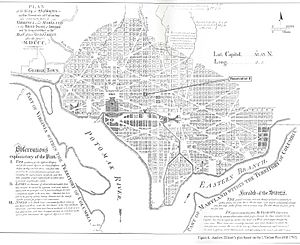National Capital Parks facts for kids
The National Capital Parks is a special group of places managed by the National Park Service in the United States. It includes many different areas owned by the government in and around Washington, D.C.. These places include important memorials, monuments, parks, and even the green spaces inside traffic circles and squares.
Contents
History of the Parks
How Washington, D.C. Was Chosen and Designed
In 1790, the U.S. Congress passed a law called the Residence Act. This law allowed President George Washington to choose a spot along the Potomac River for the new capital city of the nation.
In 1791, President Washington asked Pierre Charles L'Enfant to design the city that would become Washington. Three special Commissioners were in charge of overseeing the development of what would be called the District of Columbia. L'Enfant's original plan was later changed by Andrew Ellicott after L'Enfant had disagreements with the Commissioners. President Washington eventually removed L'Enfant from the project.
The design of the city created many of the open spaces that are now part of the National Capital Parks.
How Park Lands Were Acquired
The first lands for the National Capital Parks were obtained because of the Residence Act of 1790. Between 1790 and 1867, many important areas became public property. These included the Mall, the Monument Grounds, the Capitol Grounds, President's Park, Lafayette Park, Franklin Park, and Garfield Park. A total of 301 separate areas in the original City of Washington were acquired. Much of this land is still owned by the government today and is part of the National Capital Parks.
During the American Civil War (1861–1865), the Union Army built many forts to protect the city. These fortifications led to more land becoming federally owned.
In 1924, Congress created the National Capital Park Commission. Its job was to buy land in the District. This land was used to create and protect the sites of the Civil War forts and to build connecting parkways.
In 1926, Congress passed another law to create a system of parks from the Civil War forts. This law allowed the government to buy more land to build a parkway ring around the city. This area is now known as the Fort Circle Parks. Even though the full roadway was never built, the land is still owned by the government.
In 1933, the control of parklands in the District was given to the National Park Service. This created a new part of the National Park System called the National Capital Parks. This unit was not created by a specific law. Instead, it was formed by an Executive Order. This order combined several government agencies, including the Public Buildings and Public Parks of the National Capital, into one office under the Department of the Interior. In 1935, the name of this office was changed back to the National Park Service.
In 1975, the Baltimore–Washington Parkway also became part of this unit.
How the Parks Are Managed Today
Today, the National Capital Parks is still an official unit of the National Park System. However, different parts of the National Park Service manage the parklands:
- National Capital Parks-East – This unit manages National Park properties in the eastern part of the District, including some areas in Maryland.
- National Mall and Memorial Parks – This unit used to be called National Capital Parks-Central. It manages all the properties in and around the National Mall.
- White House and President's Park – This unit manages The White House, a visitor center, Lafayette Square, and The Ellipse.
- Rock Creek Park – This unit manages properties in the northern and northwestern parts of the District.
- George Washington Memorial Parkway – This unit manages properties in Virginia. It also manages some areas in the District, such as Clara Barton Parkway, Theodore Roosevelt Island, Arlington Memorial Bridge, and the Columbia Island parks. These include Lady Bird Johnson Park, Lyndon Baines Johnson Memorial Grove, Navy – Merchant Marine Memorial, and the Columbia Island Marina.
- Chesapeake and Ohio Canal National Historical Park – This unit manages the entire C&O Canal National Historical Park, including the part that is inside the District.


